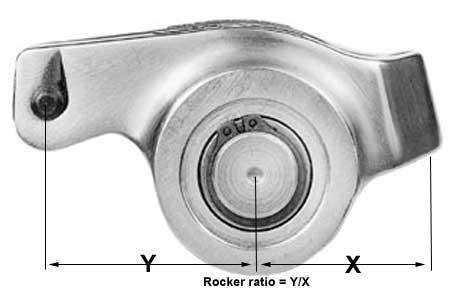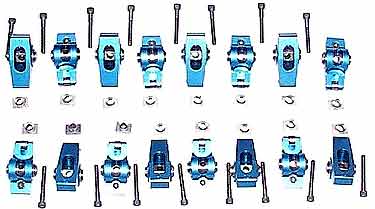|
Rocker
Arm Ratios: Is more better?

Introduction
What
modification should I do next? It is the proverbial question,
pondered by every automotive enthusiast at least once a day.
Most of us use the same universal formula for deciding upon
the next performance modification -the mod which will provides
the most gain for the least amount of money and effort.
One of the modifications that seems to meet this criteria
are higher ratio roller rockers. The increased ratio in effect
is like installing a slightly larger cam, and the roller bearing
fulcrum and tip provide slight gains in power and longevity
by reducing frictional losses.
In this article Tech Editor Jim Langley replaces the stock
sled style rocker arms on a stock 5.0L engine, and tests whether
this modification is worth anything at the dragstrip.
Before
we get into the installation and results, let's review in
detail the theory behind increasing the rocker arm ratio.
The rocker arm is the link between the camshaft and the valves
- functioning as a lever arm to multiply the cams lobe lift
to the valve lift. Stock rocker arm ratios vary between manufacturers
and engine types, but generally all small block Fords come
with a 1.6:1 ratio rocker arm.
Virtually all the aftermarket camshaft manufacturers offer
high-quality aluminum roller rockers in ratios greater than
stock. For small block Fords you can easily round up a set
of 1.7:1 or 1.72:1 rockers from Crane, Comp Cams, Harland
Sharp or Omega. For the Cleveland and 429/460 motors most
companies offer a 1.8:1 ratio rocker arm over the 1.73:1 production
ratio. Winston Cup engines can be setup with as much as 2.0:1
rocker arm ratios.
Are there any cons to higher ratio rockers? The answer is
yes. The increased leverage can contribute to faster valve
guide wear, especially if pushrod length is not properly checked
and adjusted. The increased lift may also necessitate a stiffer
set of valve springs, or springs with more clearance before
bind. Finally be sure to check for sufficient clearance under
the valve covers, as the beefier rocker arms can hit baffles
or other parts of the cover.

Lift
and Duration
We all know that stepping up to a cam with a little more lift
and duration can yield a nice gain in performance. Unfortunately
cam swaps are time consuming, and when you factor in the cost
of the cam, lifters, gaskets, and fluids, it quickly becomes
a project not worth tackling -especially on a stock motor.
The idea behind increasing the rocker arm ratio is to essentially
give the motor a slightly larger cam, without all the hassle.
Naturally, decreasing the rocker arm ratio provides the opposite
effect -making the cam events slightly smaller. The side bar
above shows how we can calculate the valve lift as a result
of changing the rocker arm ratio.
Many people incorrectly assume that a change in rocker arm
ratio has no effect on the duration the valves are open. In
actuality there is some change to the duration at the valve
depending on the lobe profile of the camshaft. Comp Cams explains
that by lifting the valve an additional 7-8%, but beginning
and ending the lift at the same point, the opening and closing
rates become steeper. This increases duration, measured at
the valve at 0.050" lift, by 1-2 degrees. You can measure
the actual duration change by using a degree wheel and dial
indicator set on the valve retainer. Coincidentally the principle
of a steeper rate of opening and closing is what Comp Cams
has engineered into their Extreme energy camshafts to enable
more valve duration for a given lobe duration.

|

